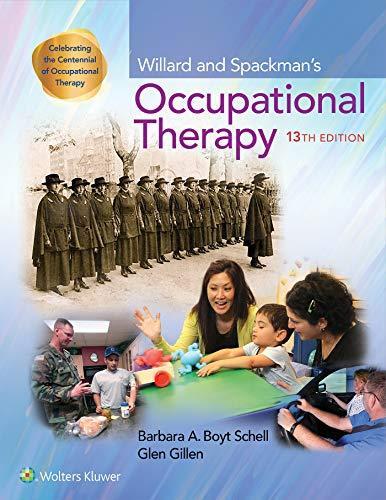ReviewerRecognition
JosephCipriani,EdD,OTR/L Professor,DepartmentofOccupationalTherapy MisericordiaUniversity Dallas,Pennsylvania
SandraBarkerDunbar,DPA,OTR/L,FAOTA Professor,OccupationalTherapyDepartment HealthProfessionsDivision,CollegeofAlliedHealthandNursing NovaSoutheasternUniversity FortLauderdale–Davie,Florida
SueCoppola,MS,OTR/L,BCG,FAOTA
AssociateProfessor,DivisionofOccupationalScience UniversityofNorthCarolina ChapelHill,NorthCarolina
CristyDaniel,MS,OTR/L CollegeofSaintMary Omaha,Nebraska
DeniseDonica,DHS,OTR/L AssistantProfessor,OccupationalTherapyDepartment EastCarolinaUniversity Greenville,NorthCarolina
AnneM.Haskins,PhD,OTR/L OccupationalTherapyDepartment UniversityofNorthDakota GrandForks,NorthDakota
LianeHewitt,DrPH,OTR/L
AssociateProfessorChair,DepartmentofOccupationalTherapy LomaLindaUniversity LomaLinda,California
HeatherJavaherian,OTD,OTR/L LomaLindaUniversity LomaLinda,California
PamelaKasyan-Itzkowitz,MS,OTR/L,CHT OccupationalTherapyDepartment NovaSoutheasternUniversity FortLauderdale–Davie,Florida
JanePainter,EdD,OTR/L AssociateProfessor,Director,ClinicalEducation CollegeofAlliedHealthSciences,OccupationalTherapyDepartment EastCarolinaUniversity Greenville,NorthCarolina
AmyPaul-Ward,PhD,MSOT AssistantProfessor,DepartmentofOccupationalTherapy CollegeofNursingandHealthSciences FloridaInternationalUniversity Miami,Florida
GreshundriaM.Raines,OTD,MPA,OTR/L AssistantProfessorandAcademicFieldworkCoordinator DepartmentofOccupationalTherapy AlabamaStateUniversity Montgomery,Alabama
JaneeneSibla,OTD,MS,OTR/L UniversityofMary Bismarck,NorthDakota
StacySmallfield,DrOT,OTR/L UniversityofSouthDakota Vermillion,SouthDakota
TheresaSmith,PhD,OTR,CLVT TexasWoman’sUniversity Houston,Texas
BethP.Velde,OTR/L,PhD
Professor,OccupationalTherapyDepartment
AssistantDean,CollegeofAlliedHealthSciences
EastCarolinaUniversity
Greenville,NorthCarolina
CallieWatson,OTD,OT/L
CollegeofSaintMary
Omaha,Nebraska
LEARNINGOBJECTIVES
TheNeedforCommunityPractice
Occupationaltherapypractitionersrecognizethat“stayingwithinthemedical modeldeprivessocietyofthefullbenefitsofanoccupationalapproach”(Miller& Nelson,2004,p.138).Communitypracticeopensthedoorfortheprofessionof occupationaltherapytogrowandapplyoccupationinitsnaturalsettings.Yetcommunitiesarecomplexanddynamic,andaddressinghealthissuesincommunities iscomplicatedbyfactorssuchasreimbursement,community-definedneeds,and healthdisparities.Currenthealthcaresystemslacktheabilitytoadequatelyaddress communityhealthissues,healthdisparities,healthpromotion,andhealthbehaviors,whichlaysthegroundworkforoccupationaltherapypractitionerstoactively exploreanddefinerolesincommunitypractice(Scaffa,2001;Fazio,2008).Because ofthesechallengesinthehealthcaresystem,occupationaltherapypractitionerscan adopt
aclient-centered,communityapproachthatrequirespractitionerstohave theskillstoworkeffectivelyinindividual,dyadic,group,andcommunity interactionstoimplementrestorativeaswellaspreventiveandhealthmaintenanceprogramsthatenhancethefunctionandwell-beingofclients.(Baum &Law,1998,p.9)
Withthedrasticchangesinhealthcareservices,therisingcostsofhealthcare, andthetimeconstraintsonprovidinghealthcarecausedbyfundinglimitations, anincreasingdemandforcommunityhealthprogramshasdevelopedacrossthe disciplines(Merryman,2002;Fazio,2008).Tomeetthesedemands,communities areturningtohealthcareprovidersforassistancetomeettheneedsofcommunity members(Baum&Law,1998;Suarez-Balcazar,2005).Furthermore,insurance costshaverisendrastically,forcingindividualsandemployersthatprovidehealth insurancetoexploretheroleofhealthmaintenanceandwellnessasamethodfor reducingcosts(CovertheUninsured,2008).Allofthesefactorsjustifytheneedfor occupationaltherapypracticeincommunitysettings.
Theprofessionofoccupationaltherapyisbecomingmoreproactiveinaddressinghealthneedsthatarise,expandingoutsidearehabilitationapproach.Examples ofthisincludefallpreventionprogramsanddrivingprograms(Dorne&Kurfuerst, 2008).Programssuchasthesedemonstrateashiftintheprofessionfromrehabilitatingthosewhoareillordisabledtofacilitatinghealthyliving,aginginplace,and qualityoflifeforall.Mostoftheseprogramsoccurinacommunitysetting.
UnderstandingCommunityPracticeinOccupational Therapy
Definingcommunitypracticeinoccupationaltherapyischallengingbecauseofits encompassingnatureanditsdifferencesfromtraditionalpractice.Inthecommunitysetting,occupationaltherapypractitioners“havenorecipeforsuccessinthis
realmofpractice,nostandardtreatmentplanstofollow,noscheduledtimestoperformactivitiesofdailylivingtreatments”(Loukas,2000).Occupationaltherapy practiceincommunitysettingsisbroad,andprogramsareuniquetoeachcommunityandpractitionerworkinginthecommunity.Occupationaltherapyinterventionsmove“beyondtheindividualtreatmentofaclienttoworkingwith systemsthataffecttheabilityofanindividualorgrouptoachievework,leisure,and socialgoals”(Brownson,1998,p.61).AccordingtotheOccupationalTherapy PracticeFramework(OTPF),occupationaltherapypractitionersmustconsider clientsnotonlyasindividualsbutalsoasbothorganizationsandpopulations withinacommunity(AOTA,2008).Becausecommunitiesarecollectiveinnature, occupationaltherapypractitionersincommunitypracticemustexploreinnovative waysofpracticing,notjustnewvenuesforpractice(Brownson,1998).
Communitypracticeinoccupationaltherapyexplores“theroleofoccupation intheshapingofasocietyandadailylife”(Fidler,2001,p.7).McColl(1998)proposesthatoccupationaltherapypractitionersincommunitysettings“needbasic knowledgeaboutthenatureanddistributionofdisabilityandoccupationand aboutthedeterminantsofsuccessfulcommunitylivingwithadisability”(p.11). Butbeyondunderstandingtheexperienceofindividualswithadisabilitylivingin thecommunity,communitypracticeinvolvesunderstandingthecollectivewhole. Asdiscussedpreviously,communitiesareuniqueandexhibitcollectiveoccupations.Evenwhenaddressingindividualclients,theimpactofthecommunityand relationshipswithinitareinstrumentaltooccupationalengagement(Fazio,2008). Wilcock(2006)suggeststhat“occupationprovidesamechanismforsocialinteractionandsocietaldevelopmentandgrowth,formingthefoundationofcommunity”(p.9).Asindividualsexperiencechallengestooccupationalengagement,so docommunities.Occupationaltherapypractitionersmustunderstandtheseconceptstoapplytheminacommunitysetting.
Communitypracticeprovidesaclearpictureofthedynamicsthataffectaperson’s abilitytopracticehealthyoccupations.Thedifferencebetweencommunitypractice andtraditionalmedicalpracticeissimple:“Communitypracticeexistsintheclient’s ‘reallife’and‘realworld’”(Siebert,2003,p.2).Infact,alltheaspectsthataffecthealth andoccupationalengagementmustbeconsideredinthecommunitysettingbecause thismakestherapymoreapplicableandclient-centered(Brownson,1998).For example,whenanoccupationaltherapistcompletesahomesafetyassessment,the practitionercaneasilyviewbarriersandaccessibilityissues.Obviously,thisapproach hasanadvantageoversimplyinterviewingtheclientinaninpatientsettingabouthis orherperceivedbarriersandaccessibilityissuesinthehome.Clientperceptionsare validandimportant,yetadiscussionabouthomesafetythatisconductedintheinpatientsettingisremovedfromthedynamicenvironmentandcommunitycontextin whichthepersonengagesdaily.Practicingincommunitysettingsprovidespractitionerswitharealisticviewoftheclient’slifeandpromotesbettertreatmentoutcomesbecausesuggestionsandtherapyoccurincontext.
Fazio(2008)suggeststhattoengageincommunitypracticesuccessfully,the occupationaltherapypractitionermustadoptasystemsapproach(Gray,Kennedy, &Zemke,1996a;Gray,Kennedy,&Zemke,1996b).Occupationaltherapypractitionersareinterestedinoccupationrelatedto“thedynamicsofthisprocesswithin thelargersystemofenvironment/community”(Fazio,2008,p.25).Communities arecomplex,withmultipledynamicsallinteractingandinterconnected.Occupationaltherapypractitionersmustfindarolethatcanfacilitatepositivehealth changesinthissystem(Fazio,2008).
Bybeinginacommunity,practitionerscanperceivecommunitymembers’barriersandchallengestohealthyliving.Manyfactorsthataffecthealtharenotvisibleinclinicalsettingsbecausetheenvironmentiscontrolledbythehealthcare system.Inthecommunity,manyfactorsaffectanindividual’sabilitytolivehealthily.Forexample,AmericanIndianslivingonareservationtypicallyreceivefederal foodcommodities,whichdictatefoodavailability.Tellingaclienttoeathealthyis simple,butobviouslyreservation-basedAmericanIndiansmayfinditdifficultto complywiththissuggestionbecauseofthelimitedfoodchoicesavailable.Clients arechallengedbyissuessuchasnutritionalaccess,andpractitionersmusttakeinto accounttheseissueswhenworkingwithcommunities.Whenprovidingservicesin communitysettings,practitionersmustknowthecommunityinordertoimplementhealthcarerecommendationsandtreatmentsthatmeettheneedsofthecommunitymembersandthatacknowledgechallengestobasichealthmaintenance (Fazio,2008).Factorssuchasfoodaccessaffecttheoverallhealthofacommunity andimplytheneedforhealthcarepractitionerstounderstandthecommunitycontexttofacilitatehealthyliving.
Communitiescanbecollectivelyhealthyorunhealthyasaresultofmanyfactors.Forexample,incitieswithreliableandaccessibletransportationsystems,individualswithphysicaldisabilitiescangettoworkontime.Becauseoftheaccessible andreliabletransportationsystem,thesecommunitymemberscanmakeasocietal contributionandareabletosustainalivingincome,whichimprovesqualityoflife forallmembersofthecommunity.Incommunitieswheretransportationisnot reliableoraccessible,individualswithphysicaldisabilitiesmaynotbeabletomaintainajobandcannotmakealivingwage.Becauseoflackoftransportationservices, individualswithphysicaldisabilitiesarealienatedandmayexperienceadecreased qualityoflife.Thisexamplehighlightstheimpactunderstandingtherolecommunityplaysinoccupationalengagement.
Theoccupationaltherapyprofessionhasidentifiedpracticesettingsinwhich occupationaltherapypractitionerscanprovideoccupationaltherapy–relatedservices(Scaffa,2001);however,theconceptsandframeworkofcommunitypractice inoccupationaltherapyhavenotbeenformallyoutlinedoracceptedintheprofession.Becauseofthislackofacollectiveprofessionaldefinitionofcommunity practice,occupationaltherapypractitionersmustbegintodefinecommunitypractice.Occupationaltherapypractitionershavetheopportunitytoexploretheimpact
ofoccupationaltherapypracticeincommunitiesanddefinethespecificrolethe professionwillplayincommunityhealth.
TheRolesofOccupationalTherapyPractitioners intheCommunity
Itisimportantforreaderstohaveabasicunderstandingoftherolesofoccupationaltherapypractitionersincommunitysettings.Asmentioned,nospecificstandardsforcommunitypracticeexist;however,becauseofthenatureofcommunity practice,specificrolesandresponsibilitieshaveemergedandarediscussedinthe literature.Theserolesareoftennotpractice-basedbutdescribethegeneralcharacteristicsapractitionerneedstobesuccessfulincommunitysettings.These includeadvocacy,assessmentskills,capacitybuildingskills,andtheabilitytoapply theprinciplesofoccupationinacommunitycontext.Obviously,theserolesand responsibilitiesarebroadandeachcommunitypractitionerwillfinddifferent activitiesassociatedwitheachofthesegeneralizedroles.Thefollowingsubsections describethesecharacteristicsfurther.
Advocacy
LET’SSTOPANDTHINK
Thinkofacommunityyoubelongto thatisimportanttoyou.Brainstorm waysinwhichyouwouldengagein advocacyforthatcommunity.Think ofspecificwaysyoucouldadvocate bothasamemberofthat communityandasanoccupational therapypractitioner.
Incommunitypractice,occupationaltherapypractitionersarerequiredtoadvocatefor clientsformultiplereasons.Advocacyispartoftheprinciplesandvaluesoftheprofession(AOTA,1993).Althoughadvocacyisimportantinalloccupationaltherapypracticesettings,ittakesonauniqueroleincommunitysettings(Jensen&Royeen,2002) wherepractitionersaddresshealthissuesnottypicallycoveredby insuranceprovidersandmayworkwithanunderservedpopulationthatcannotaffordservices.Thepractitionermustdiscover andexplorefeasibleapproachestoaddresshealthissuesinthe community,whichrequiresadvocacyonmanylevels,fromeducatingcommunitymembersontheroleofoccupationaltherapy practitionerstoadvocatingfortheneedsofunderservedcommunities(Herzberg&Finlayson,2001).Forexample,identifyinga healthproblemanddevelopingaprogramtoaddressthisproblemisaformofadvocacy(Kingetal.,2002;Scaletti,1999).Writingagranttofundservicesisalsoaformofadvocacy.
Practitionersmustalsoadvocateforpromotionofinclusionofallinthecommunity(Grady,1995)becausecommunityinvolvementisan importantcomponentofqualityoflifeandself-esteemforindividuals.Practitionersmightsometimesneedtoadvocateinregardtograntfunding,especiallywhen fundingstreamsareeliminatedorthreatenedasaresultofpoliticaldebate,economics,trends,orchangesinadministration(Jensen&Royeen,2002).Incommunitypractice,anoccupationaltherapypractitionermaybecalledtocontactor communicatewithpoliticalofficialstovoicesupportforinitiatives.
TABLE1-1OCCUPATIONALTHERAPYROLESINADVOCACY
•Education
•Addressingunmethealthneeds
•Servingtheunderservedthroughhealth-relatedprograms
•Promotinginclusion
•Politicaladvocacy
AssessmentSkills
Occupationaltherapypractitionersincommunitypracticerequireuniqueassessmentskills.Incommunityprogramdevelopment,mostinterventionsarefora groupandnotforanindividual;thereforeoccupationaltherapypractitionersin communitypracticemustlearnhowtoassessgroupsofpeopleregardingoccupationalengagementandperformance(Brownson,1998;Fazio,2008).Somepractitionersmayfindthisachallengebecauseitdeviatesfromthetraditional therapist–clientrelationshipanddeliverymodel.Furthermore,communityassessmentrequiresskillsinmultipledatacollectionmethodsanddataanalysis.It requiresanunderstandingofepidemiologyandhowcommunitydatacanbeused inprogramdevelopmentandgrantwriting(Fazio,2008;Wilcock,2006).
Inadditiontogatheringinitialassessmentdata,occupationaltherapypractitionersinthecommunitymustcollectongoingevaluationdata.Knowledgeand understandingofprogramevaluationmethodsarecrucialtothesuccessofany program(Suarez-Balcazar&Harper,2003).Evaluationmethodsarevitalto improvecommunityprogramsandensurethatprogramsaddresstheirintended purposes.Assessmentalsohelpstobuildevidenceandsciencedrivenapproachesthatarenecessarytojustifyfundingand developmentofcommunitypracticeinthefieldofoccupationaltherapy.
Gainingskillsinassessmentcanbechallengingtonovice practitioners.Methodsandstrategiesfordevelopingthese skillsarediscussedlaterinthetext.Assessmentnotonlyprovidesfeedbackonaprogram’soutcomesbutcanleadtoexternalfundingsupportandpotentialpolicydevelopment (Suarez-Balcazar,2005).
BuildingCommunityCapacity
BESTPRACTICEHINT
Outcomedatafromassessmentcan beusedinadvocacyby demonstratinganeedand justifyinghowaprogramcan affectacommunity’shealthina positiveandeffectiveway.
Communitycapacitybuilding canbedefinedasexploringandunderstandinga community’spotentialorabilitytoaddresshealthproblems(Chino&DeBruyn, 2006;Goodmanetal.,1998).Althoughallcommunitieshaveneeds,inunderserved
communitieswhereseverehealthdisparitiesexistandissuessuchasaccesstocare permeate,itcanbechallengingtoexplorecommunitycapacity.Althoughoccupationaltherapypractitionershavebeentrainedtoidentifyproblemsorneeds,in everycommunity,theymustlookbeyondneedtoidentifycapacityandassetsfor addressinghealthissues(Fazio,2008).
LET’SSTOPANDTHINK
Thinkofacommunityyoubelong tothatisimportanttoyou.What doesthecommunityhavetooffer thatisuniqueorbeneficial?Write downwhatyouidentifyand reflectonhowthesecapacities couldbeusedinthecontextof communityoccupationaltherapy practice.
Toengagecommunitycapacitybuilding,occupationaltherapypractitioners mustbe community-centered andapplyclient-centeredpracticetothecommunity.Inclient-centeredpractice,practitionersseektounderstandthegoalsofthecommunitymembersin asimilarwayastohowtheyseektounderstandtheindividual clientintraditionaltherapist–clientinteractions(McColl, 1998).Communityinterventionsthatarebasedonanddevelopedusingcommunity-identifiedneedsbuilduponcommunitystrengthsandhavebeensuccessful(Kretzmann& McKnight,1993;Elliott,O’Neal,&Velde,2001).Occupational therapypractitionersmustunderstandtheoccupationalprofileofthecommunitytodevelopmeaningfulinterventions thatarebasedonoccupationalpreferences(Brownson,1998).
ApplyingOccupationintheCommunityContext
Occupationaltherapypractitionersinthecommunitymustunderstandoccupationinacommunitycontext(Fazio,2008).Occupationaltherapypractitionersare expertsonoccupationandhavearguedthatoccupationisa“fundamentalprerequisiteofwellbeingandlinkedittoanindividual’sstateofhappiness,self-esteem andphysicalandmentalhealth”(Scriven&Atwal,2004,p.427;Wilcock,2006). However,incommunitypractice,practitionersmustunderstandoccupationsboth ontheindividualandcommunitylevels.Becauseillnessandhealthareaffectedby diseaseaswellasexternalcontextandhealthinfrastructure,occupationaltherapy practitionersmusttransformtraditionalbeliefsaboutoccupationtoapplyoccupationonmultiplelevels.Occupationcanbeappliedinthecommunitycontext throughprogramdevelopmentandgrantwriting,thefocusofthistext.
SkillsRequiredforCommunityPractice
Occupationaltherapypractitionersinthearenasofcommunityhealth,public health,community-basedpractice,andcommunity-builtpracticerequireaunique setofskillstoachievesuccess.Fidler(2001)statesthat“respondingtothevaried needs,interestsandwelfareofacommunitywilldifferinorientation,attitudinal andknowledgebasefromtheonethatcurrentlyguidesoureducationandpractice”(p.8).Despitethisfact,someskillsrequiredforcommunitypracticetransfer easilyfromtheclinicalsettingtoacommunitypracticesetting,whereasothers requiredevelopmentandexperience.
TABLE1-2COMMUNITYOCCUPATIONALTHERAPYPRACTITIONER SKILLS
•Consultancy
•Education
•Autonomy
•Client-centeredpractice
•Clinicalreasoning
•Healthpromotion
•Networking
•Managementskills
•Programevaluationskills
•Culturalawareness
•Teamskills
Accordingtoasurveyofcommunityoccupationaltherapistsconductedby MitchellandUnsworth(2004),communityoccupationaltherapistsneedtopossess thefollowingskillsandcharacteristics:consultancy,education,autonomy,clientcenteredpractice,clinicalreasoning,andhealthpromotion.AstudybyLemorieand Paul(2001)indicatesthatcommunityoccupationaltherapy practitionersneedtoknowhowtodothefollowing:network, navigatecommunityresources,managevolunteers,evaluate programs,healthpromotion/diseaseprevention,andaddress multiculturalpracticeissues.Fazio(2008)discussesskills requiredofoccupationaltherapypractitionersincludingcommunicationskills,abilitytodevelopcollaborativerelationships, managementskills,andleadershipskills.Furthermore,occupationaltherapypractitionersincommunitysettingsneedtobe abletointeractwithaninterprofessionalteamthatincludes bothprofessionalsandvaluedcommunitymembers(Baum& Law,1998;Paul&Peterson,2001;Miller&Nelson,2004).
BESTPRACTICEHINT
Manypractitionersfeelintimidated bycommunitypractice.Abest practicehintistoseekoutamentor orsupportgroupofpractitioners thatworkinthecommunity.By participatinginanetwork, practitionerscandevelopskills importanttocommunitypractice.
Occupationaltherapypractitionersincommunitysettingscanfindaroleinconsultancy(Mitchell&Unsworth,2004;Lysack,Stadnyk,Krefting,Paterson,& McLeod,1995).Forexample,anoccupationaltherapypractitionercanserveonthe boardofdirectorsforahealth-relatednonprofitorbeanactive memberofacommunitycoalition.Intheseroles,theoccupationaltherapypractitionerprovidesadviceasanexpertinoccupationorsomeothercomponentoftheprofession.Even thoughtheoccupationaltherapypractitionerdoesnotprovide directserviceorengageindirectprogramdevelopment,heor sheactsasanadvisortotheseprocesses,whichleadstoprofessionaldevelopmentandknowledgeaboutcommunitypractice. Educationisakeycomponentofcommunitypractice.Occupationaltherapypractitionersusuallytakeonaneducatorrole. AccordingtoBrownson(2001),community“programsare
BESTPRACTICEHINT
Toexplorecommunitypractice occupationaltherapypractitioners canjoinaboardofdirectorsor advisoryboardofacommunity organization.Servinginthis capacityhelpsthepractitioner learnabouttheprocessesof communityorganizations.
Considerthemultipletheoretical approachesthatoccupational therapypractitionersincommunity settingsmustemploy(public health,epidemiology,systems theory,sociology,organizational psychology,andsociology).Identify whichaspectsfromeach theoreticalapproachoccupational therapypractitionersmightusein communitypractice.
distinguishedfromclinicalservicesinthatprogramsareprimarilyeducational”(p. 96).Providingeducationisasignificantcomponentofcommunitypracticewhen practitionersexplorehealthpromotionandlifestylemodification.Occupationaltherapypractitionersincommunitysettings needtohavestrongeducativeskills(Scaffa,2001).Perhapstheir mostsignificantchallengeistotackleeducationinamannerthat fitstheneedsofthecommunity,gearingeducationtothecultureandhealthliteracylevelsofthecommunitymembers.
Thetenetsofcommunitypracticedrawfromavarietyof socialsciencesincludingpublichealth,epidemiology,systems theory,sociology,organizationalpsychology,andsociology (Munoz,Provident,&Hansen,2004).Occupationaltherapy practitionerscanuseelementsfromeachsourceastoolsfor communitypractice.Practitionersincommunitypractice mustcommittolifelonglearningandmakeongoingeffortsto experimentandstrategizeforsuccess.
ModelsofPracticeintheCommunity
Inoccupationaltherapy,therearetwomainapproachestopractice:community-based practiceandcommunity-builtpractice.Occupationaltherapypractitionersmust decidewhichapproachworksbestfortheneedsoftheirpracticeandthecommunity. Inthissection,eachapproachisexploredanddescribedasavaluableframework.
Community-BasedPractice
Community-basedpractice isthelocationinwhichoccupationaltherapyservicesareprovided.Inthismodel,specificlocationswithinthecommunitycontext areidentifiedandtheskillsofandrolesthatoccupationaltherapypractitionerscan playinthesettingaredescribed.Examplesincludeadultdaycareprograms,driving rehabilitationprograms,andhealthpromotionprograms(Scaffa,2001;McColl, 1998).AccordingtoWittmanandVelde(2001),community-basedpractice“refers toskilledservicesdeliveredbyhealthpractitionersusinganinteractivemodelwith clients”(p.3).
Forcommunity-basedpractice,occupationaltherapypractitionersmustmove awayfromthemedicalmodelandfocusonahealthpromotionanddiseasepreventionapproachtohealthcaredelivery(Scaffa,2001).Scaffa,Desmond,and Brownson(2001)encourageoccupationaltherapypractitionerstoadoptarolein healthpromotionprogramdevelopmentbyprovidinganoccupation-basedperspectiveordevelopingoccupation-basedprogrammingtocomplementcurrent healthpromotionprograms.
Programdevelopmentisasignificantcomponentofcommunitypractice.Itcan becomparedtotheoccupationaltherapyprocessandincludesthefollowingsteps:
TABLE1-3THEORETICALFRAMEWORKSUTILIZEDINCOMMUNITYBASEDPRACTICE
OccupationalTherapyTheoriesTheoriesOutsideOccupationalTherapy ModelofHumanOccupationSocialLearningTheory EcologyofHumanPerformanceHealthBeliefModel
OccupationalAdaptationPrecede-ProceedModel
Person-Environment-OccupationalTranstheoreticalModelofHealthBehavior PerformanceModel Change
Source: Scaffa,M.(Ed.).(2001). Occupationaltherapyincommunity-basedpractice settings. Philadelphia:F.A.Davis.
preplanning,needsassessment,plandevelopment,implementation,evaluation,and institutionalization(Brownson,2001).Programdevelopmentwillbediscussedin furtherdetailinChapter2.Community-basedpracticehasbeenwidelyacceptedin occupationaltherapy.Thecommunity-basedpracticeapproachtransferspractice skillsfromtheclinicalsettingtoapopulation-basedprogramdevelopmentmodel.
Community-BuiltPractice
Community-builtoccupationaltherapyprogramsare“opensystemsinconstant interactionwiththeirphysical,natural,temporal,socialandpoliticalenvironment” (Elliottetal.,2001,p.106).Thebasisofthe community-builtpractice modeliscollaborationwithastrength-basedapproachand“endswhentheclient-definedcommunityhaseffectivelybuiltthecapacityforempowerment”(Wittman&Velde, 2001,p.3).Community-builtpracticeisfoundedonthefollowingprinciples:
1. Eachcommunitymemberandcommunityhasstrengths. Inthecommunitybuiltpracticemodel,eachcommunitymemberandcommunityisevaluated forstrengths.Practicefocusesonhealthpromotionandwellnessandrecognizestheabilityofeachindividualandcommunitytobuildcapacityforsuccess.Itisassumedthatthecommunitywillembracethepracticeand,atsome self-definedpoint,nolongerneedtheoccupationaltherapyservices.
2. Communitymembersareequalpartnersinprogramdevelopment, implementation, andevaluation. Accordingtothecommunity-builtpractice model,communityprogramscanbesuccessfulonlyiftheyreceivethebuyinofcommunitymembersandinvolvethemintheprogramplanningand implementation.Communitymembersaretheexpertsinthecommunity’s culture,dynamics,politics,andhealthissuesandarethestrongestresource ofanycommunityprogram.Thecommunity-builtpracticemodelrecognizesthisfactandusesitasastrategyforsuccess(Wittman&Velde,2001).
3. Communitymembers“own”theprogram. Thecommunityprogram shouldnotdependonexpertsor“outsiders”tobesuccessfulbutshould becomeembodiedbythecommunity.Thisprocesstakestimeandisnotwell definedinthecommunity-builtmodelbecausecommunitiesvary;butthe ultimategoalofcommunity-builtpracticeisforthecommunitytoassume responsibilityfortheprogram.
4. Theoccupationaltherapypractitionermustbeculturallyawarefortheprogramtosucceed (Barnardetal.,2004;Wittman&Velde,2001).Inmostcases, theoccupationaltherapypractitionercomesfromaculturalbackgrounddifferentfromthecommunitymembers.Culturalawarenessandculturaldesire (Campinha-Bacote,2001)areskillsrequiredofthepractitionerfortheprogramactivitiestohaveanimpact.
Community-builtpracticeisanemergingmodelinoccupationaltherapypracticethatisbasedoncommunity-andcapacity-buildingmodelsinpopulationbasedandhealthpromotionpractice(Wittman&Velde,2001).
Community-BasedPracticeversusCommunity-BuiltPractice
Bothcommunity-basedpracticeandcommunity-builtpracticearemodelsusedas frameworksforcommunitypractice.Althoughbothmodelsfocusoncommunity practice,theydifferintheirapproachesandphilosophies.
Acommunity-basedoccupationaltherapyprogramtakesplaceinthecommunitycontext.Itfocusesonapplyingtheconceptsofoccupationaltherapypractice tocommunitysettingstodevelopprogramsthataddressoccupationalneeds. Braveman(2001)sharesanexampleofacommunity-basedprogramforaddressingtheworkrehabilitationneedsofindividualswithHIV/AIDS.Theprogram, basedontheModelofHumanOccupationandprovidedaspartoftheservices offeredbyacommunityorganization,providesfourphasesofintervention:Phase 1focusesonself-assessmentandexplorationofrolesandhabits,phase2focuses ondevelopingskillsrequiredforwork,phase3includesemploymentplacement withsupport,andphase4provideslong-termfollow-upandsupportinthenew workrole.Todeveloptheprogram,Braveman(2001)followedaprogramdevelopmentmodelproposedbyGrossmanandBortone(1986)andimplementedthe programwithinacommunitycontext.
Community-builtpracticeutilizesacollaborationmodelandfocusesonthe needsandcapacitiesofthecommunityanditsmembers.Thecommunity-built modelreferstothisaspectinitstitle: Community is built withtheoccupational therapypractitionerasfacilitator.Barnardandcolleagues(2004)in“Wellnessin Tillery”describeanexampleofacommunity-builtmodel.Tilleryisasmall,rural towninNorthCarolinawithalargeAfricanAmericanpopulation.Studentsinthe EastCarolinaUniversityOccupationalTherapyprogramwereassignedtodevelop programmingfollowingacommunity-builtmodel.Studentswereaskedto
immersethemselvesinthecommunitytolearnaboutthepeopleandtofacetheir ownbiasesaboutthecommunity.Throughbuildingrelationships,thestudents wereabletocollaboratewiththeolderAfricanAmericansinthecommunityto developtheOpen-MindedSeniorsWellnessProgram,aprogramfocusedonphysicalactivity,spirituality,nutritioneducation,andcognitionactivities.Through surveysandfeedback,theprogramwasabletoincreaseseniorwellnessand improveoverallqualityoflifeamongthecommunitymembersinvolved.Theprogram’ssuccessisattributedtotheconceptsofthecommunity-builtmodel,which includecollaborativeplanningandimplementation,equalpartnershipsinprogramimplementation,andasenseofcommunityownershipoftheprogram.
Bothmodelsofcommunitypracticeofferapproachesand methodsfortheoccupationaltherapypractitioner.The community-basedmodelfocusesonavarietyofhealthpromotionandprogramdevelopmentapproacheswhereasthe community-builtmodelprovidesastructuredwayofviewing thecommunityandprogramdevelopment.Occupational therapypractitionersmustdeterminewhichapproachbest suitstheirclinicalreasoningandthecommunitytheyplanto partnerwith.Examplesofcommunity-basedandcommunity-builtpracticeprogramsexistintheliteraturetoaidthepractitionerinpickingamodelbestsuited forpractice.
PublicHealthandOccupationalTherapy
AccordingtoHildenbrandandFroehlich(2002),theaimof publichealthisto“mobilizeresourcestoensurehealthsupportingconditionsforallpersons.”Wilcock(2006)argues thatoccupationaltherapistshavearoleinpublichealth.On theotherhand,ScrivenandAtwal(2004)question“whether theprofessionhasthecompetenciesandcapacitytojoinothersinthepublichealthworkforcewithupstreamremitsand responsibilities”(p.428;Scaffa,VanSlyke,&Brownson, 2008).Despitethedebate,theroleofoccupationaltherapy practitionersincommunitypracticefollowsatraditionalpublichealthmodel.
BESTPRACTICEHINT
Exploretheliteratureformodelsof community-basedpracticeand community-builtpracticeto identifywhichmodelbestsuitsyou.
BESTPRACTICEHINT
Manystateshavepublichealth organizationssimilartostate occupationaltherapyassociations. Exploremembershipinthepublic healthorganizationofyourstate tolearnmoreandtonetworkwith publichealthprofessionals.
Healthpromotionisakeycomponentofpublichealth.AccordingtotheWorld HealthOrganization(2008),healthpromotionis“theprocessofenablingpeopleto increasecontrolovertheirhealthanditsdeterminants,andtherebyimprovetheir health.”Ingeneral,theoccupationaltherapyliteratureacknowledgesthatpractitioners’rolesincommunitypracticeareto“workwithclientstopromotehealthand overcomearangeofphysical,socialandemotionalbarriersandproblemstomaximisetheclient’squalityoflife”(Mitchell&Unsworth,2004,pp.14–15).Formany
occupationaltherapypractitioners,practicemaydelveintohealthpromotion, whichtightlyalignswiththetenetsofpublichealth(Baum&Law,1998).
Practitionerswhoareunfamiliarwiththeconceptsofpublichealthmayfindit difficulttotransitiontoapublichealthframework.HildenbrandandFroehlich (2002)arguethatoccupationaltherapypractitionershaveafundamentalroleto playinpublichealth,includingthepromotionofhealthmaintenanceforindividualswithorwithoutdisabilities,developmentofoccupation-basedcommunity programs,andparticipationonteamsofpublichealthprofessionalsinvolvedin healthpromotionprogramming.Theyencourageoccupationaltherapypractitionerstoembracearoleinpublichealth,statingthat“publichealtharenasof healthmaintenance,diseaseprevention,andhealthpromotionofferanewvision ofopportunityforpersonalchallenge,professionaldevelopment,anddiscipline expansion.”
Accordingto ThePromotionofHealthStatementandthePreventionofDisease andDisability publishedbytheAmericanOccupationalTherapyAssociation, occupationaltherapypractitionerscanplayaroleinhealthpromotionthroughthe promotionofhealthyliving,useofoccupationasavehicleforhealingandhealth maintenance,andtheprovisionofinterventionsfocusedonbothindividualsand populations(Scaffaetal.,2008).Thedocumentgoesontostatethat“becauseof theinextricableandreciprocallinksbetweenpeopleandtheirenvironments,larger groups,organizations,communities,populations,andgovernmentpolicymakers mustalsobeconsideredforintervention”(p.420).
Incommunitypractice,therearethreemainareasofhealthpromotionasoutlinedbyScrivenandAtwal(2004):primaryhealthpromotion,secondaryhealth promotion,andtertiaryhealthpromotion.Followingtraditionaldefinitionsofprevention, primaryhealthpromotion isdefinedas“activitiesthattargetthewell populationandaimtopreventillhealthanddisabilitythrough,forexample,health educationand/orlegislation.” Secondaryhealthpromotion “isdirectedatindividualsorgroupsinordertochangehealth-damaginghabitsand/ortopreventill healthmovingtoachronicorirreversiblestageand,wherepossible,torestorepeopletotheirformerstateofhealth.” Tertiaryhealthpromotion occurs“withindividualswhohavechronicconditionsand/oraredisabledandisconcernedwith makingthemostoftheirpotentialforhealthyliving”(Scriven&Atwal,2004,p. 425).Eachlevelofprevention/promotionfocusesonadifferentsubsetofthepopulation.Primarypreventionexploreshealthforallindividualswhereassecondary preventionfocusesonworkingwithpeoplewhohaveidentifiedriskfactorsand tertiarypreventionfocusesonthosewhoalreadyhaveanexistingconditionaffectingtheirlives.
Occupationaltherapypracticeisfueledbythebeliefthatwellnessandhealth derivefromengagementinoccupation(Fazio,2008).Thisveryfundamentalprincipledefinestheroleofoccupationaltherapypractitionersinpublichealthandpreventionincommunitysettings.
















